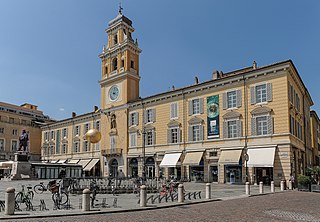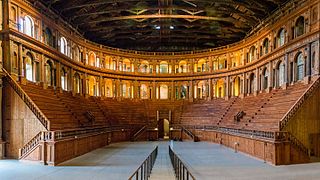
Parma is a city in the northern Italian region of Emilia-Romagna known for its architecture, music, art, prosciutto (ham), cheese and surrounding countryside. With a population of 198,292 inhabitants, Parma is the second most populous city in Emilia-Romagna after Bologna, the region's capital. The city is home to the University of Parma, one of the oldest universities in the world. Parma is divided into two parts by the stream of the same name. The district on the west side of the river is Oltretorrente. Parma's Etruscan name was adapted by Romans to describe the round shield called Parma.

The Duchy of Parma and Piacenza was an Italian state created in 1545 and located in northern Italy, in the current region of Emilia-Romagna.

The House of Farnese was an influential family in Renaissance Italy. The titles of Duke of Parma and Piacenza, Duke of Latera and Duke of Castro were held by various members of the family.

Carlo Cignani was an Italian painter. His innovative style referred to as his 'new manner' introduced a reflective, intimate mood of painting and presaged the later pictures of Guido Reni and Guercino, as well as those of Simone Cantarini. This gentle manner marked a break with the more energetic style of earlier Bolognese classicism of the Bolognese School of painting.

The Palazzo della Cancelleria is a Renaissance palace in Rome, Italy, situated between the present Corso Vittorio Emanuele II and the Campo de' Fiori, in the rione of Parione. It was built 1489–1513 by Baccio Pontelli and Antonio da Sangallo the Elder as a palace for Raffaele Cardinal Riario, Camerlengo of the Holy Roman Church, and is regarded as the earliest Renaissance palace in Rome.

The Palazzo Ducale di Mantova is a group of buildings in Mantua, Lombardy, northern Italy, built between the 14th and the 17th century mainly by the noble family of Gonzaga as their royal residence in the capital of their Duchy. The buildings are connected by corridors and galleries and are enriched by inner courts and wide gardens. The complex includes some 500 rooms and occupies an area of c. 34,000 m2, which make it the sixth largest palace in Europe after the palaces of the Vatican, the Louvre Palace, the Palace of Versailles, the Royal Palace of Caserta and the Castle of Fontainebleau. It has more than 500 rooms and contains seven gardens and eight courtyards. Although most famous for Mantegna's frescos in the Camera degli Sposi, they have many other very significant architectural and painted elements.

Palazzo Farnese is a palace in Piacenza, northern Italy.

The Ducal Palace, also known as Reggia di Colorno, is an edifice in the territory of Colorno, Emilia Romagna, Italy. The palace we see today was refurbished by Francesco Farnese, Duke of Parma in the early 18th century on the remains of a former castle.

Léon Guillaume (du) Tillot was a French politician infused with liberal ideals of the Enlightenment, who from 1759 was the minister of the Duchy of Parma under Philip, Duke of Parma and his wife Princess Louise-Élisabeth of France. At a time when both Bourbon France and Bourbon Spain thought of Parma as a strategic point of interest, Tillot favoured French policies abroad and wide-ranging reforms within the Duchy of Parma. He was made marchese di Felino.

Teatro Farnese is a Renaissance theatre in the Palazzo della Pilotta, Parma, Italy. It was built in 1618 by Giovanni Battista Aleotti. The idea of creating this grand theater came from the Duke of Parma and Piacenza Ranuccio I Farnese. It was part of the complex of the Ducal Palace of Parma. The theatre was almost destroyed by an Allied air raid during World War II (1944). It was rebuilt and reopened in 1962.

The Biblioteca Palatina or Palatina Library was established in 1761 in the city of Parma by Philip Bourbon, Duke of Parma. It is one of the cultural institutions located in the Palazzo della Pilotta complex in the center of Parma. The Palatina Library was named after Apollus Palatinus.
Giovanni Battista Magnani was an Italian architect working entirely in Parma in the first half of the 17th century. He was the most successful of a family of masons and architects that included his father Nicostrato and his son Carlo.

The Galleria nazionale di Parma is an art gallery in Parma, northern Italy.

Ennemond Alexandre Petitot (1727-1801) was a French-born architect, mainly active in the Duchy of Parma.

The Palazzo di Riserva, also known as the Palazzo delle Poste because for long it hosted the offices of the Postal Service, is a Neoclassical-style palace in central Parma, region of Emilia Romagna, Italy. The large structure now hosts the Museo Glauco Lombardi displaying collections from 19th-century Parma, as well as offices of the postal service, the provincial forestry service, a literary club, and several shops. It has been much altered over the years.

The Accademia di Belle Arti di Parma is an artistic institution in the city of Parma, Italy. It is presently located in a wing of the Palazzo della Pilotta in the center of the city.

The Palazzo del Giardino or Palazzo Ducale del Giardino is a historic palace in the Parco Ducale in Parma. It is not to be confused with the official Parma residence of Marie Louise, Duchess of Parma between Palazzo della Pilotta and Palazzo della Provincia in what is now known as piazzale della Pace - she also lived at the Ducal Palace of Colorno and in the Casino dei Boschi in Sala Baganza. The main Ducal Palace in Parma, the Palazzo della Pilotta and the Reinach Theater were all destroyed in an early morning air raid on 13 May 1944, carried out by the 465th Heavy Bombardment Group of the US Airforce, 781st Squadron, which dropped 9 GP bombs on the city centre.

The Ducal Palace of Parma was a neoclassical palace in Parma, Italy. It was located on the west side of the Piazzale della Pace. Between its construction and 1859, it was the residence of the Dukes of Parma. After 1859, it became the prefecture.



















